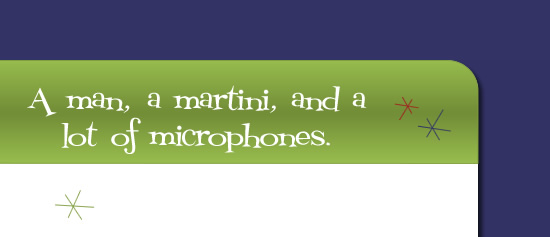Psst... want to learn a quick trick?
It's late, I'm still up reading chapters from a book on SOA (don't ask), and I've got less than four hours before I have to be up for my day tomorrow.
So let me pass along a quick trick that might just help you out the next time you're in a voiceover session. It's my way of passing the time before I can actually fall asleep, but also gives me a chance to teach a trick that you might be able to put to good use.
For this trick, you're going to need a half-decent preamp, but really any preamp will do so long as it has the ability to trim the output. I'm going to use a Great River MP-2NV to illustrate what I mean:
You can see that there's a gain knob and an output level knob.
Here's the trick. We want to make this discrete, transformer preamp sound like a tube pre. Piece of cake, but most people who use these for spoken word don't try it. Maybe they don't know, or they just prefer to use the top end of the preamp... I don't know. What I do know is that when we over-saturate the transformer in this preamp (or any preamp with a good transformer; I think the MP-20 might be another good example... and it was less than $500 when it was originally available on the market) we get that "tubey" sound caused by the harmonic distortion achieved by squeezing the input in this fashion. In a lot of cases, this is a really fun, and useful means of giving some character to our voiceover tracks (I've found it to be particularly good for narrations or something that required a "tubey" sound when I didn't want to actually use a tube preamp; on some preamps, you'll have an effect that is similar to using a compressor... each preamp is a little different).
Your recorded tracks will be a little more defined in the mix using this technique, but be warned that this is a trick you want to use sparingly. For the most part, it's smarter practice to track your voice over clean and go from there (and yes, you can run a prerecorded track into certain preamps and do this trick if you'd like; the LMNOPre is a personal favorite of mine, but personally I'm addicted to that preamp... God only knows how I'd react to an NPNG preamp).
BTW: you can also do this trick with tube-based preamps as well, but you'll probably notice that you quickly move from and extremely tubey sound to something that sounds like it just went through a limiter (especially with the LaChapell preamps using stock tubes for some reason).
Each preamp is a bit different, but that's part of the fun. You can find many different ways to get to the same end result so long as you have the skill.
So let me pass along a quick trick that might just help you out the next time you're in a voiceover session. It's my way of passing the time before I can actually fall asleep, but also gives me a chance to teach a trick that you might be able to put to good use.
For this trick, you're going to need a half-decent preamp, but really any preamp will do so long as it has the ability to trim the output. I'm going to use a Great River MP-2NV to illustrate what I mean:
You can see that there's a gain knob and an output level knob.
Here's the trick. We want to make this discrete, transformer preamp sound like a tube pre. Piece of cake, but most people who use these for spoken word don't try it. Maybe they don't know, or they just prefer to use the top end of the preamp... I don't know. What I do know is that when we over-saturate the transformer in this preamp (or any preamp with a good transformer; I think the MP-20 might be another good example... and it was less than $500 when it was originally available on the market) we get that "tubey" sound caused by the harmonic distortion achieved by squeezing the input in this fashion. In a lot of cases, this is a really fun, and useful means of giving some character to our voiceover tracks (I've found it to be particularly good for narrations or something that required a "tubey" sound when I didn't want to actually use a tube preamp; on some preamps, you'll have an effect that is similar to using a compressor... each preamp is a little different).
Your recorded tracks will be a little more defined in the mix using this technique, but be warned that this is a trick you want to use sparingly. For the most part, it's smarter practice to track your voice over clean and go from there (and yes, you can run a prerecorded track into certain preamps and do this trick if you'd like; the LMNOPre is a personal favorite of mine, but personally I'm addicted to that preamp... God only knows how I'd react to an NPNG preamp).
BTW: you can also do this trick with tube-based preamps as well, but you'll probably notice that you quickly move from and extremely tubey sound to something that sounds like it just went through a limiter (especially with the LaChapell preamps using stock tubes for some reason).
Each preamp is a bit different, but that's part of the fun. You can find many different ways to get to the same end result so long as you have the skill.
Labels: preamp, recording, studio, voice over











0 Comments:
Post a Comment
Subscribe to Post Comments [Atom]
<< Home